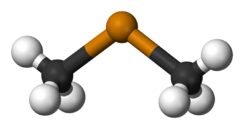Chemistry:Dimethyl telluride

| |

| |
| Names | |
|---|---|
| Preferred IUPAC name
(Methyltellanyl)methane | |
| Other names
Dimethyltellurium[1] (additive)
Dimethyltellane | |
| Identifiers | |
3D model (JSmol)
|
|
| 1696849 | |
| ChEBI | |
| ChemSpider | |
| EC Number |
|
| 1480 | |
| KEGG | |
| MeSH | dimethyltelluride |
PubChem CID
|
|
| |
| |
| Properties | |
| C2H6Te | |
| Molar mass | 157.67 g·mol−1 |
| Appearance | Pale yellow, translucent liquid |
| Odor | Garlic |
| Melting point | −10 °C (14 °F; 263 K) |
| Boiling point | 82 °C (180 °F; 355 K) |
| Related compounds | |
Related chalcogenides
|
Dimethyl oxide (dimethyl ether) |
Related compounds
|
Hydrogen telluride Diphenyl telluride |
Except where otherwise noted, data are given for materials in their standard state (at 25 °C [77 °F], 100 kPa). | |
| Infobox references | |
Dimethyl telluride is an organotelluride compound, formula (CH3)2Te, also known by the abbreviation DMTe.
This was the first material used to grow epitaxial cadmium telluride and mercury cadmium telluride using metalorganic vapour phase epitaxy.[2][3]
Dimethyl telluride as a product of microbial metabolism was first discovered in 1939.[4] It is produced by some fungi and bacteria (Penicillium brevicaule, P. chrysogenum, and P. notatum and the bacterium Pseudomonas fluorescens).[5]
The toxicity of DMTe is unclear. It is produced by the body when tellurium or one of its compounds are ingested. It is noticeable by the garlic smelling breath it gives those exposed, similar to the effect of DMSO. Tellurium is known to be toxic.[6]
References
- ↑ "dimethyl telluride (CHEBI:4613)". Chemical Entities of Biological Interest (ChEBI). UK: European Bioinformatics Institute. 25 September 2006. IUPAC Names. https://www.ebi.ac.uk/chebi/searchId.do?chebiId=4613. Retrieved 19 September 2011.
- ↑ Tunnicliffe, J.; Irvine, S. J. C.; Dosser, O. D.; Mullin, J. B. (1984). "A new MOVPE technique for the growth of highly uniform CMT". Journal of Crystal Growth 68 (1): 245–253. doi:10.1016/0022-0248(84)90423-8. Bibcode: 1984JCrGr..68..245T.
- ↑ Singh, H. B.; Sudha, N. (1996). "Organotellurium precursors for metal organic chemical vapour deposition (MOCVD) of mercury cadmium telluride (MCT)". Polyhedron 15 (5–6): 745–763. doi:10.1016/0277-5387(95)00249-X.
- ↑ Bird, M. L.; Challenger, F. (1939). "Formation of organometalloidal and similar compounds by microorganisms. VII. Dimethyl telluride". Journal of the Chemical Society 1939: 163–168. doi:10.1039/JR9390000163.
- ↑ Basnayake, R. S. T.; Bius, J. H.; Akpolat, O. M.; Chasteen, T. G. (2001). "Production of dimethyl telluride and elemental tellurium by bacteria amended with tellurite or tellurate". Applied Organometallic Chemistry 15 (6): 499–510. doi:10.1002/aoc.186.
- ↑ Chasteen, T. G.; Bentley, R. (2003). "Biomethylation of Selenium and Tellurium: Microorganisms and Plants". Chemical Reviews 103 (1): 1–26. doi:10.1021/cr010210+. PMID 12517179.
- Liu, M.; Turner, R. J.; Winstone, T. L.; Saetre, A.; Dyllick-Brenzinger, M.; Jickling, G.; Tari, L. W.; Weiner, J. H. et al. (2000). "Escherichia coli TehB Requires S-Adenosylmethionine as a Cofactor to Mediate Tellurite Resistance". Journal of Bacteriology 182 (22): 6509–6513. doi:10.1128/JB.182.22.6509-6513.2000. PMID 11053398.
- Scott, J. D.; Causley, G. C.; Russell, B. R. (1973). "Vacuum ultraviolet absorption spectra of dimethyl sulfide, dimethyl selenide, and dimethyl telluride". The Journal of Chemical Physics 59 (12): 6577–6586. doi:10.1063/1.1680037. Bibcode: 1973JChPh..59.6577S.
- Gharieb, M. M.; Kierans, M.; Gadd, G. M. (1999). "Transformation and tolerance of tellurite by filamentous fungi: accumulation, reduction, and volatilization". Mycological Research 103 (3): 299–305. doi:10.1017/S0953756298007102.
External links
- Epichem (Commercial supplier datasheet)
 |

